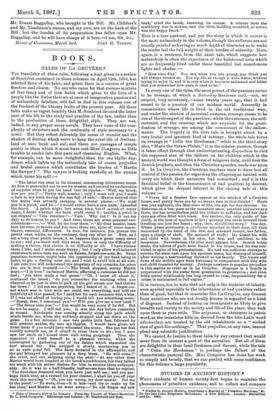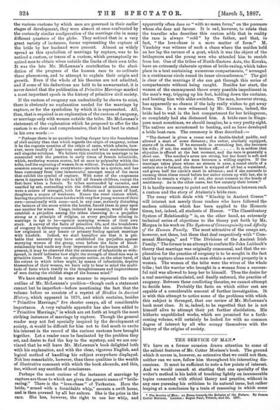STUDIES IN ANCIENT HISTORY.*
Wnzn students of human society first began to examine the phenomena of primitive existence, and to collect and compare • Sandie. in Ancient Hidory. comprisieg. Reprint of "Primitive Marriage," as. By the late John Ferguson McLennan. A New Edition. London Macmillan sad Co. 1886. the various customs by which men are governed in their earlier stages of development, they were almost at once confronted by the curiously similar configuration of the marriage rite in many different quarters of the globe. They noticed that in a very great variety of instances, forms representing the capture of the bride by her husband were present. Almost as widely spread as this symbolism of marriage by capture,-was to be noticed a custom, or traces of a custom, which peremptorily re- quired men to obtain wives outside the limits of their own tribe. It was the late Mr. McLennan's contribution to the eluci- dation of the progress of the human race to coordinate these phenomena, and to attempt to explain their origin and growth. Even if the whole of his theories are not admitted, and if some of his deductions are held to be unwarranted, it is never denied that the publication of Primitive Marriage marked a most important epoch in the history of primitive civil society.
If the custom of exogamy can undoubtedly be shown to exist, there is obviously no explanation needed for the marriage by capture, or for the symbolism by which it is represented. All, then, that is required is an explanation of the custom of exogamy, or marriage only with women outside the tribe. Mr. McLennan's statement of the explanation which he proposed to offer for the custom is so clear and comprehensive, that it had best be stated in his own words :— " Perhaps there is no question leading deeper into the foundations of civil society than that which regards the origin of exogamy, unless it be the cognate question of the origin of caste, which admits, how- ever, more readily of ingenious surmises, and what mathematicians call singular solutions. We believe this restriction on marriage to be connected with the practice in early times of female infanticide, which, rendering women scarce, led at once to polyandry within the tribe, and the capturing of women from without. Female infanticide— common among savages everywhere—prevails as a system, and has been customary from time immemorial amongst many of the races that exhibit the symbol of capture. With some of the exogamous races it appears to be the rule to kill all female children, except the first-born when a female. To tribes surrounded by enemies, and unaided by art, contending with the difficulties of subsistence, sons were a source of strength, both for defence and in quest of food, daughters a source of weakness. Hence the cruel custom which, leaving theprimitive human hordes with very few young women of their own—occasionally with none—and, in any case, seriously disturbing the balance of the sexes within the hordes, forced them to prey upon one another for wives. Usage, induced by necessity, would in time establish a prejudice among the tribes observing it—a prejudice strong as a principle of religion, ae every prejudice relating to marriage is apt to be—against marrying women of their own stock. A survey of the facts of primitive life, and the breakdown of exogamy in advancing communities, excludes the notion that the law originated in any innate or primary feeling against marriage with kinsfolk. Indeed, we shall hereafter see that it is pro- bable that necessity may have established the prejudice against marrying women of the group, even before the facts of blood- relationship bad made any deep impression on the human mind. At present, it may be observed that the existence of infanticide so wide- spread, in itself indicates how slight the strength of blood-ties was in primitive times. To form an adequate notion, on the other hand, of the extent to which tribes might, by means of infanticide, deprive themselves of their women, we have only to bear in mind the multi- tude of facts which testify to the thoughtlessness and improvidence of men during the childish stage of the human mind."
We have attempted in some manner to represent the main outline of Mr. McLennan's position—though such a statement cannot but be imperfect—before mentioning the fact that the volume before us consists of a reprint of Studies in Ancient History, which appeared in 1876, and which contains, besides " Primitive Marriage," five shorter essays, all of considerable
importance. A very valuable appendix has also been added to "Primitive Marriage," in which are set forth at length the most striking instances of marriage by capture. Though the general reader may not feel specially inspired by the development of society, it would be difficult for him not to find much to excite his interest in the record of the curious customs here brought together. Let a reader once be fascinated by the problem they set, and desire to find the key to the mystery, and we are con- vinced that he will leave Mr. McLennan's book delighted both with his explanation, and with the clear, vigorous English, and logical method of handling his subject everywhere displayed. Not less remarkable, however, than these qualities is the wealth of illustrative comment with which the book abounds, and this, too, without any sacrifice of conciseness.
Perhaps the most curious of the instances of marriage by capture are those to which are given the generic name of "bride- racing." There is the "love-chase" of Turkestan. Here the bride, " armed with a formidable whip," mounts a swift home, and is then pursued by all her suitors. She is the prize in the race. She has, however, the right to use her whip, and
apparently often does so "with no mean force," on the pursuers whom she does not favour. It is sad, however, to relate that the traveller who describes this custom adds that in reality the race is always "sold" by the father, and that, in fact, " the love-chase is a mere matter of form." M. Vambdry was witness of such a chase where the maiden held on her lap the carcass of a goat, which it was the object of the bridegroom and the young men who attended him to snatch from her. One of the tribes of North-Eastern Asia, the Koraks, have an extremely elaborate system of bride-racing, which takes place in a tent containing numerous compartments, " arranged in a continuous circle nand its inner circumference." The girl is clear of the marriage if she can get through this series of compartments without being caught. Besides her start, the women of the encampment throw every possible impediment in the man's way, tripping up his feet, holding down the curtains, and beating him with alder-switches. The man, however strong, has apparently no chance if the lady really wishes to get away from him. In a race witnessed by Mr. Kerman, indeed, the bride had to wait in the last compartment for her bridegroom, so completely had she distanced him. A. bride-race in Singa- pore mast sometimes, we should imagine, be a very pretty eight. The natives are accustomed to boating, and so have developed a bride boat-race. The ceremony is thus described
The damsel is given a canoe and a double-bladed paddle, and allowed a start of some distance; the suitor, similarly equipped, starts off in chase. If he succeeds in overtaking her, she becomes his wife; if not, the match is broken off It is seldom that objection is offered at the last moment, and the race is generally a short one. The maiden's arms are strong, but her heart is soft and her nature warm, and she soon becomes a willing captive. If the marriage takes plane where no stream is near, a round circle of a certain size is formed, the damsel is stripped of all bat a waistband, and given half the circle's start in advance; and if she succeeds iu running three times round before her suitor comes up with her, she is entitled to remain a virgin ; if not, she must consent to the bonds of matrimony. As in the other cases, but few outstrip their lovers."
It is hardly necessary to point out the resemblance between such a custom and the story of Atalanta's bride-race.
The essay which deals with "Kinship in Ancient Greece" will interest not merely those readers who have followed the modern criticism which has been applied to the Homeric times, hat, indeed, all students of Homer. "The Classificatory System of Relationship " is, on the other hand, an extremely technical series of objections to the theory put forth by Mr. Morgan in his work on The Systems of Consanguinity and Affinity of the Human Family. The most attractive of the essays are, however, not these, but those that deal respectively with " Com- munal Marriage," and "The Divisions of the Ancient Irish Family." The former is an attempt to confute Sir John Lubbock's theory that marriage was originally communal, and that the ex- planation for the practice of exogamy is to be sought in the fact that by capture alone could a man obtain a several property in a woman. The women of the tribe were the wives of the whole tribe; but the warrior who brought in a woman from a success- ful raid was allowed to keep her to himself. Thus the desire for a real marriage stimulated, and finally enforced, the practice of exogamy. Between these conflicting theories, we cannot attempt to decide here. Probably the facts on which either rest are capable of a considerable amount of further investigation. It is with this attempt to notice some of the problems with which this subject is thronged, that our review of Mr. McLennan's book must close. It is, indeed, to be regretted that he is not himself alive to attempt their yet further elucidation. His hitherto unpublished works, which are promised for a forth- coming volume, will certainly be looked for with no common degree of interest by all who occupy themselves with the history of the origins of society.



































 Previous page
Previous page